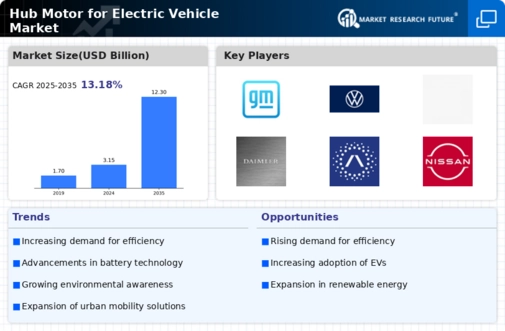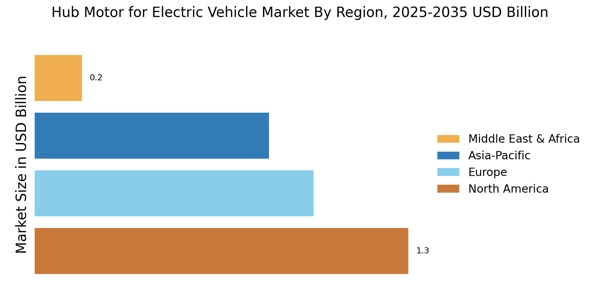Rising Demand for Electric Vehicles
The increasing demand for electric vehicles (EVs) is a primary driver for the Hub Motor for Electric Vehicle Market. As consumers become more environmentally conscious, the shift towards EVs is accelerating. In 2025, the number of electric vehicles on the road is projected to surpass 30 million units, indicating a robust growth trajectory. This surge in demand necessitates innovative solutions, such as hub motors, which offer enhanced efficiency and performance. Hub motors, integrated directly into the wheel, provide advantages like reduced weight and improved space utilization, making them an attractive option for manufacturers. Consequently, the Hub Motor for Electric Vehicle Market is poised to benefit significantly from this trend, as automakers seek to meet consumer preferences for sustainable and efficient transportation.
Expansion of Charging Infrastructure
The expansion of charging infrastructure is a critical driver for the Hub Motor for Electric Vehicle Market. As more charging stations are established, the practicality of owning electric vehicles increases, leading to higher adoption rates. In 2025, the number of public charging stations is projected to reach over 1 million globally, facilitating easier access to charging for EV owners. This development not only alleviates range anxiety but also encourages manufacturers to invest in advanced technologies, such as hub motors, which can enhance vehicle performance. The synergy between improved charging infrastructure and the Hub Motor for Electric Vehicle Market is likely to foster a more robust market environment, promoting further innovation and adoption of electric vehicles.
Government Incentives and Regulations
Government incentives and regulations aimed at promoting electric vehicle adoption are significantly influencing the Hub Motor for Electric Vehicle Market. Many countries have implemented policies that encourage the use of EVs through tax rebates, subsidies, and stricter emissions standards. For example, in 2025, several regions are expected to offer substantial financial incentives for consumers purchasing electric vehicles equipped with advanced technologies, including hub motors. These initiatives not only stimulate demand for electric vehicles but also create a favorable environment for manufacturers to invest in hub motor technology. As a result, the Hub Motor for Electric Vehicle Market is likely to experience accelerated growth, driven by supportive governmental frameworks.
Technological Innovations in Hub Motors
Technological advancements in hub motor design and manufacturing are propelling the Hub Motor for Electric Vehicle Market forward. Innovations such as improved power density, enhanced thermal management, and advanced materials are making hub motors more efficient and reliable. For instance, the introduction of high-performance magnets and lightweight composites has led to a reduction in overall vehicle weight, which is crucial for maximizing range. Furthermore, the integration of smart technologies, such as regenerative braking and real-time monitoring systems, enhances the functionality of hub motors. As these technologies continue to evolve, they are likely to attract more manufacturers to adopt hub motors in their electric vehicle designs, thereby expanding the Hub Motor for Electric Vehicle Market.
Consumer Preference for Compact and Efficient Designs
The growing consumer preference for compact and efficient vehicle designs is a notable driver for the Hub Motor for Electric Vehicle Market. As urbanization increases, consumers are seeking vehicles that are not only environmentally friendly but also space-efficient. Hub motors, which are integrated into the wheel assembly, allow for more flexible vehicle designs and maximize interior space. This trend is particularly evident in the rise of micro-mobility solutions, such as e-scooters and compact electric cars, which are gaining popularity in urban areas. The demand for such vehicles is expected to grow, thereby enhancing the appeal of hub motors. Consequently, the Hub Motor for Electric Vehicle Market stands to gain from this shift in consumer preferences.


















Leave a Comment